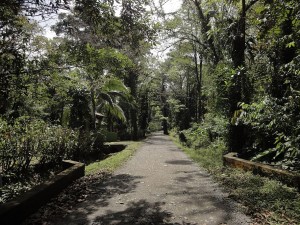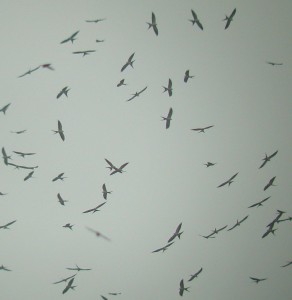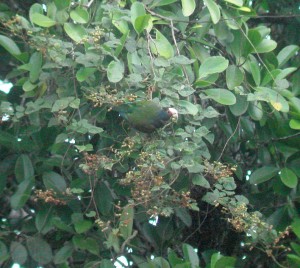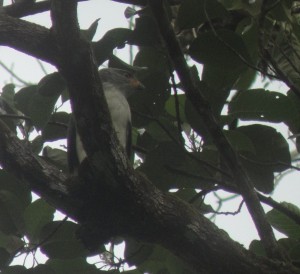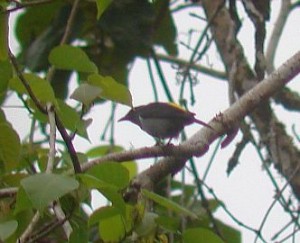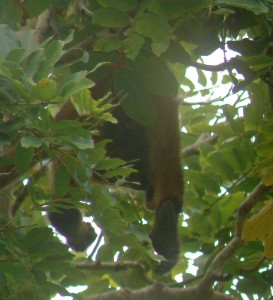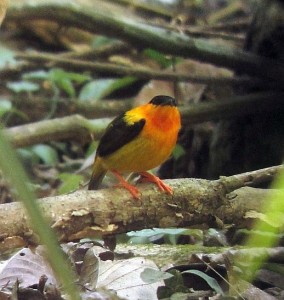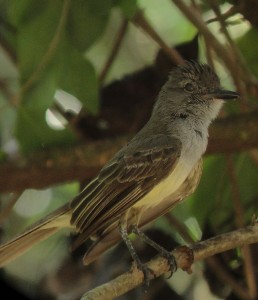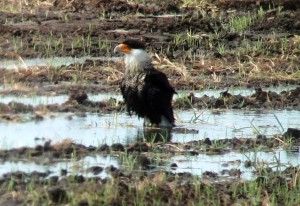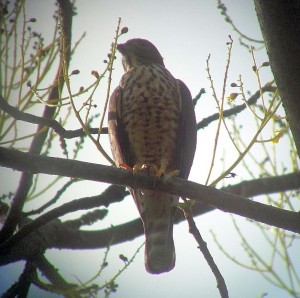The Manzanillo-Puerto Viejo area doesn’t make it onto the birding radar of most first time birders to Costa Rica. It’s too much of detour to take, especially when you can see many of the same birds around the Sarapiqui area. Nevertheless, Manzanillo and many parts of southeastern Costa Rica are more forested than most of the more commonly visited sites and guess what? That part of the country has better Caribbean lowland forest birding.
There, I said it and I stand by that statement. Things may even out when you take travel time and accommodations into consideration but there is simply more forested habitat in southeastern Costa Rica. The best forest is probably at Hitoy Cerere and other less accessible sites (and even Hitoy isn’t all that simple to reach) but even the forests from Cahuita south to Manzanillo can offer up excellent lowland birding. Much of the most accessible forests are old cacao plantations that left most of the big canopy trees and this seems to work out just fine for most of the canopy birds. A lot of understory species also seem to do quite well although certain species probably need a more diverse understory to survive (studying the effects of those old cacao plantations on avian ecology and species dynamics would be a great project!).
A typical Manzanillo birding scene.
Every time I bird that area between Puerto Viejo and Manzanillo, I always drive home feeling like I barely scratched the surface. I never feel as if I have spent enough time birding in that seriously underbirded area and this past Sunday was no different. How I wish that I could have stayed for another few days or an entire week or even a month doing surveys to compare old cacao plantations and old growth forest. A weekend wasn’t enough but it sure made for some wonderful birding.
While visiting a few friends and past clients that are having fun with the birds and biodiversity around Manzanillo, we ran into a things like…
Kettles of Swallow-tailed Kites! None of us had seen 100 plus Swallow-tailed Kites circling in the sky together. I have seen fair sized flocks in Amazonia but none that were like this! They looked like a bunch of a giant, super fancy hirundines. Plumbeous Kites were also winging on past from time to time as were the first kettles of Turkey Vultures.
Great views of perched parrots and parakeets. Birding was excellent right around the small rented house where we were staying and included flyover and perched Mealy, Red-lored, Brown-hooded, White-crowned, and Blue-headed Parrots. We were hearing and seeing Mealys for much of the time and it was a pleasure getting close looks at the Blue-headeds.
Blue-headed Parrot– local in Costa Rica, very common from Panama on south.
Sort of a bad image of a feeding Brown-hooded Parrot and
a bad image of a White-crowned Parrot.
There were a fair number of hummingbirds around with Blue-chested being one of the most common. They were chip-chipping as they lekked in a bunch of places. Band-tailed Barbthroat was another one that we saw now and then and Liz found a nest!
Band-tailed Barbthroat.
We had good looks at Cinnamon and Chestnut-colored Woodpeckers (including one in town while eating lunch), saw one Rufous-winged, had many a Black-cheeked, and heard several Pale-billeds. Woodcreepers included Black-striped and Cocoa (both fairly common), and Wedge-billed, Northern Barred, and Streak-headed.
I think we would have seen more raptors with more time but in addition to the kites and two common vultures, we still logged King Vulture, Bat Falcon, Peregrine Falcon, Double-toothed Kite, Broad-winged, Common Black, and Roadside Hawks, and heard a Collared Forest Falcon. Our best raptor came in the form of a young Semiplumbeous Hawk.
This Semiplumbeous Hawk was near the top of a 40 meter tree.
Even though it was calling, it was still really tough to find just because it was perched so high up! It was easy to see how its white underparts act as camouflage when perched up in a tall tree.
Toucans were pretty common and seen quite often, Pied Puffbird was espied, and we had several flycatchers including Yellow-olive and Yellow-margined, one Brown-capped Tyrannulet heard and two other choice feathered morsels from the Caribbean lowlands:
Black-capped Pygmy Tyrant and
Black-headed Tody Flycatcher.
The pygmy-tyrant is basically a feathered bug and the tody-flycatcher is actually a miniature yellow, white, and black mechanical cyber toy that lives in the canopy (still countable though). This makes seeing them a challenge but since they are such common species around Manzanillo, we eventually got fantastic looks at both of these little weirdies. It’s a good thing they like to call or they would still be (1) undiscovered or (2) mis-labeled as insects.
Another look at the smallest Passerine in the world (a title shared with the sister Short-tailed Pygmy-Tyrant of the Amazon).
We did a bit of night-birding on two occasions and saw nothing. We did, however, hear on the second night, Vermiculated Screech Owl, Crested Owl, Mottled Owl, Common Pauraque (which is kind of like the neotropical trash night bird), and Great Potoo in the span of half an hour! Spectacled Owl and Central American Pygmy-Owl were also heard on other nights. I’m sure Black and white Owl is there too, probably comes to street lights now and then.
Tanagers were pretty nice too with Tawny-crested being fairly common, Red-throated Ant tanagers calling from the forest, and some other common species seen near the house. Oh yeah, and we also saw a few Sulphur-rumped Tanagers near the house too. Ahem, I mean SULPHUR-RUMPED TANAGER (yee haw!). That was a long-awaited lifer for yours-truly and of course the most exciting bird of the trip. Very little is known about this bird other than the fact that it is a gray songbird with a yellow lower back and rump. Well, it also has white tufts on the upper flanks and that was its most obvious feature. I missed a very nice shot by a couple of seconds but the following photo still shows the field marks even though it’s not going to make it into any nature magazines.
Voila, my lifer Sulphur-rumped Tanager. This is a truly horrendous photo but it might help with identifying one of these uncommon birds if you get a bad look.
I almost forgot about trogons, wrens, and fruitcrows. None of these have anything in common, I just forgot about them. The three expected trogon species were fairly common (Gartered, Black-throated, and Slaty-tailed) and fun to watch, we heard (and mostly saw) 6 species of wrens, and had several Purple-throated Fruitcrows.
A female fruitcrow trying to pass as a Corvid.
On the non-bird front, the place was also great for frogs (we saw many litter frogs, poison dart frogs, and heard several other species), and we saw many Howler Monkeys and even had a few Spider Monkeys.
An arboreal Costa Rican Bigfoot? Spider Monkey? Or something else!
A golden Eyelash Viper– this is why you don’t put your hands on the vegetation (or cement posts).
Overall, the birding was just entertaining with near non-stop action. Like I always say, I wish I could bird there more often, especially during migration when it’s even crazier!

